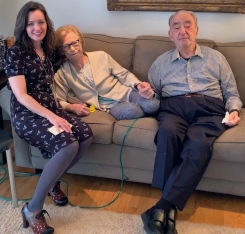VITAS Advantage: Case Study on Open Formulary for Senior Living Communities
Case Study: Patient with Advanced Cancer
RM*, an 84-year-old woman with late-stage breast cancer that has metastasized to the lungs and spine, indicates to her family and oncologist that she prefers to die comfortably in the skilled nursing facility where she has resided for 5 years.
Upon her admission to VITAS for hospice care, members of RM’s hospice team visit her facility regularly for staff education and to implement her individualized care plan that includes comfort-focused medications for her cancer-related symptoms and pain.
The VITAS open formulary includes optimized long-acting and immediate-acting opioids for RM’s nociceptive bone pain, gabapentin for nerve-related pain linked to brachial plexopathy, and nebulized medications as needed for shortness of breath. While she is still able to eat, she is prescribed an appetite stimulant for anorexia and bowel regimen for constipation. As her health declines, the focus of her care shifts primarily to comfort care and pain management, including guided imagery and chaplain visits.
Six weeks later, RM dies comfortably in her room at the facility with her family members and a hospice nurse at her bedside.
*These initials represent an anonymized patient and are used for the purposes of education only.
Families Rate Hospice as ‘Excellent,’ with Highest Ratings Linked to Longer Lengths of Stay
Family members of patients with advanced cancer who died while under hospice care are more likely than relatives of nonhospice patients to report that their loved ones received appropriate symptom relief, experienced care that honored their wishes, and died in their preferred location.
Further, the earlier patients were referred to hospice, the higher the families’ approval ratings, according to a report published in the Journal of Clinical Oncology.
“Overall, longer hospice stays were associated with family perceptions that patients received ‘just the right amount’ of pain medication, greater patient-goal attainment, and higher rates of family-reported excellent quality of end-of-life (EOL) care, compared with short stays,” write the authors. “Together, our findings suggest that encouraging hospice enrollment, particularly enrollment weeks before death, may improve EOL experiences of patients with cancer.”
Stated another way, hospice care can be a far better alternative to no hospice care at all. The VITAS open formulary provides access to a wide range of options to manage patients’ symptoms/pain and support their goals.
Investigators analyzed responses of surviving family members (n = 1,970) of 985 matched pairs of patients with advanced lung or colorectal cancers who had died either with or without hospice care.
Data came from Cancer Care Outcomes Research and Surveillance (CanCORS I and II) studies, in which nationally representative participants from five U.S. geographic regions were enrolled from 2003 through 2005 and followed through 2011.
The median length of hospice stay was 21 days (interquartile range, 7-56 days) among all 1,257 of those enrolled. Relatives of a total 2,307 decedents completed post-death interviews. More than one-third (36%) of patients were under 65 years of age, with a wide range of insurance types.
Key Findings
- Hospice patients were more often perceived as receiving “just the right amount” of pain medicine compared to nonhospice patients (80% vs 73%).
- A higher percentage of patients in hospice than of those without hospice were given “just the right amount” of help with dyspnea (78% vs 70%).
- Patients enrolled in hospice were more likely to have their EOL wishes honored compared to those not in hospice (80% vs 74%).
- Hospice enrollees were more likely to die in their preferred setting than were nonhospice patients (68% vs 39%).
- More hospice patients’ than nonhospice patients’ overall EOL care was rated as “excellent” by their families (57% vs 42%).
Importance of Hospice Length of Stay
- Families of patients enrolled for more than 30 days more frequently reported that their loved ones received “just the right amount” of pain medicine compared with those enrolled 3 days or fewer (85% vs 76%), and hospice families were more likely to rate the overall quality of care as “excellent” (65% vs 50%).
- Family members of patients in hospice for more than 30 days were more likely to report that the patients’ EOL wishes were followed “a great deal” compared with patients enrolled fewer than 3 days (87% vs 79%).
- The earlier the hospice enrollment, the greater the likelihood that patients would die in their preferred setting (more than 30 days in hospice, 75%; eight to 30 days in hospice, 67%; four to seven days in hospice, 61%; fewer than 3 days in hospice, 48%).
The VITAS Advantage for Senior Living Communities
Residents can be reassured that their symptoms and pain will continue to be managed, with a focus on comfort, once they have been referred to VITAS for hospice care. The VITAS open formulary and 24/7 clinical expertise support continuation of disease-directed medications that improve residents’ symptoms and quality of life.
Senior living community professionals can:
- Support residents who prefer to age in place with comfort-focused medications that manage the symptoms related to their primary hospice diagnosis
- Provide non-pharmacologic therapies for comfort, anxiety relief, and psychosocial support, including respiratory therapy, music therapy, pet visits, and massage therapy
- Support quality of life with home medical equipment and supplies delivered to the community, including ADL assist devices, oxygen, nebulizers, CPAP and BiPAP support, incontinence and wound care supplies, and more
Source: Kumar, P. & Wright, A. (2017). Family perspectives on hospice care experiences of patients with cancer. Journal of Clinical Oncology, 35(4):432-439

